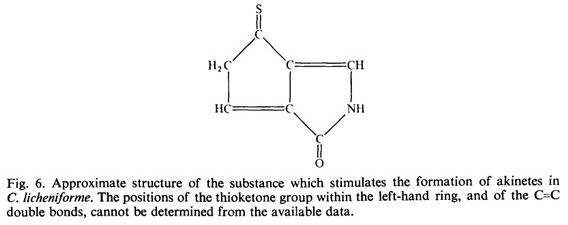|
Home / Cyanobacteria / Filaments / Unbranched / Untapered / Heterocysts / No_visible_sheath / Cylindrospermum |
||||
|
|
||||
|
|
||||
|
Click on images for larger format |
||||
Name derivation: |
||||
|
From the Greek kylindros , a cylinder, and sperma , seed. |
||||
Classification: |
||||
Cylindrospermum Kützing ex Bornet and Flahault 1886; 30 of 48 species descriptions are currently accepted taxonomically (Guiry and Guiry).Order Nostocales; Family Nostocaceae |
||||
Morphology: |
||||
|
Curved or slightly coiled cylindrical filaments composed of square or rectangular cells. The gray or blue-green colored cells lack gas vesicles but sometimes have visible granules. The Unbranched trichomes have no sheath but form mucilaginous mats. Heterocysts develop from end cells and thus are always terminal, occurring at one or both ends of the trichome. When present, large and sometimes highly ornated akinetes are adjacent to heterocysts, developing from the last vegetative cell. |
||||
Similar genera: |
||||
|
Cylindrospermopsis cells are more rectangular. It produces terminal heterocysts, but akinetes are not immediately adjacent to the heterocysts. Unlike Cylindrospermum , species of Cylindrospermopsis are planktonic sometimes forming concentrated blooms. |
||||
Heterocyst formation: |
||||
Induction of heterocysts occurs 12-15 h after fragmentation with maturity within 24 h. Absence of N2 doubled stimulation, while presence of fixed N (NH4+1 or NO3-1) inhibited heterocyst formation. Nitrogenase activity increased along with heterocyst maturity. Once matured, heterocysts apparently cannot de-differentiate into vegetative cells (Van De Water and Simon 1981). |
||||
Akinete formation: |
||||
Akinetes differentiate ~ 1 day after formation and maturity of heterocysts, thus the differentiation requires presence of heterocysts. (Ibid.)The most abundant substance in an extract of Cylindrospermum licheniforme has a molecular weight of 151 daltons and includes two pentagonal rings - C7H5OSN (Hirosawa and Wolk 1979):
|
||||
Inhibition of grazers: |
||||
DMDP (Di(hydoxymethyl)dihydroxypyrrolidine) is a gludosidase inhibitor found in Cylindrospermum lichenoforme ATCC 29412 extract, and in its culture media, that is affective against aquatic insects and microcrustaceans as an inhibitor of their digestion, thus reducing the nutritional value of the cyanobacterium. The same inhibitor is found in higher plants (Jüttner and Wessel 2003): |
||||
Habitat: |
||||
|
Most species are benthic, epiphytic (on plants) and epilithic (on rocks) in unpolluted fresh waters. |
||||
References: |
||||
|
Bornet, É. and Flahault, C. 1886 '1888'. Revision des Nostocacées hétérocystées contenues dans les principaux herbiers de France. Annales des Sciences Naturelles, Botanique, Septičme Série 7: 177-262. Guiry, M.D. and G.M. Guiry 2013. AlgaeBase. World-wide electronic publication, National University of Ireland, Galway. http://www.algaebase.org; searched on 04 September 2013. Hirosawa, T. and C.P. Wolk 1978. Isolation and characterization of a substance which stimulates the formation of akinetes in the cyanobacterium Cylindrospermum licheniforme Kütz. Journal of General Microbiology 114:433-441. Jüttner, F. and H.P. Wessel 2003. Isolation of Di(hydroxymethyl)dihydroxoypyrrolidine from the cyanobacterial genus Cylindrospermum that effectiveoy inhigits digestive golucosidases of aquatic insects and crustacean grazers. Journal of Phycology 39:26-32. |
||||
























